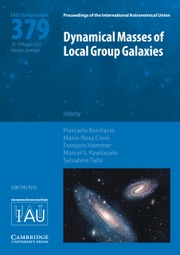No CrossRef data available.
Article contents
The SFR Efficiency of HI Gas in the Outskirts of Star Forming Galaxies
Published online by Cambridge University Press: 21 March 2017
Abstract
In order to understand the origin of the decreased star formation rate (SFR) efficiency of neutral atomic hydrogen gas measured in Damped Lyα Systems (DLAs) at z ~ 3, we measure the SFR efficiency of atomic gas at z ~ 1, z ~ 2, and z ~ 3 around star-forming galaxies. We create galaxy stacks in these three redshift bins, and measure the SFR efficiency by combining DLA absorber statistics with the observed rest-frame UV emission in the galaxies’ outskirts. We find that the SFR efficiency of Hi gas is ~ 3% of that predicted by the KS relation. We find no significant evolution in the SFR efficiency with redshift, although simulations and models predict a decreasing SFR efficiency with decreasing metallicity and thus with increasing redshift. We discuss possible explanations for this decreased efficiency without an evolution with redshift.
Keywords
- Type
- Contributed Papers
- Information
- Proceedings of the International Astronomical Union , Volume 11 , Symposium S321: Formation and Evolution of Galaxy Outskirts , March 2016 , pp. 360 - 362
- Copyright
- Copyright © International Astronomical Union 2017




